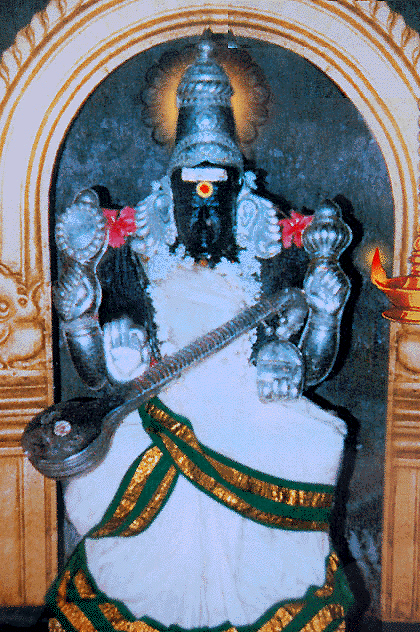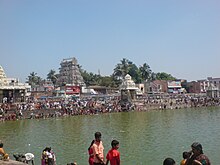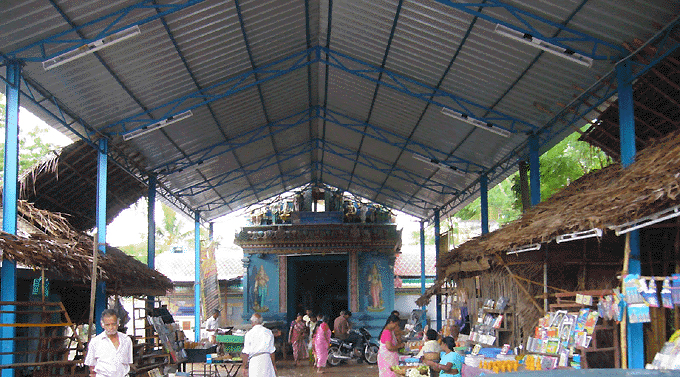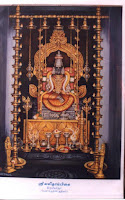In one of my earlier posts, I have mentioned about our visit to Kammangudi Sri Maha Sastha Temple. After performing our pooja and other rituals there, we proceeded to visit a couple of temples in and around Nannilam. Nannilam is a panchayat town in Thiruvarur Distirct, Tamilnadu, 30 KM east of Kumbakonam and is the main town for the nearby villages. Nannilam is the native place for noted film personalities viz. Messrs. K. Balachander, Piraisoodan and R. Mathi. This town and its surrounding areas are home to many temples and a couple of them dating back to Chola Kingdom period (about a 1000 years ago). Some of these we visited are below:
* Sri Maha Saraswathy Amman Temple, Koothanur (near Poonthottam).
* Sri Lalithambigai Temple in Thirumeeyachur (Peralam)
* Sri Vanchinadha Swamy Temple, SriVanchiyam
* Sri Pratyangara Devi Temple, Ayyavadi
Visit to Sri Maha Saraswathy Amman Temple, Koothanur:
Koothanur is situated about 2 KM on west from Poonthottam (R.S.) which is between Mayiladuthurai to Tiruvarur. and about 3 KM from Nannilam & 25 KM from Thiruvarur.
 |
| Sri Maha Saraswathy Amman |
Even now, devotees buy writing materials, note books etc. and place it under the Goddess lotus feet and get it blessed. The shops on both sides of the temple entrance sell writing materials, note books etc. as pooja materials. The Goddess adorned with a pure silk white saree and seated on a white lotus flower seat.
"ஓம் பிரம்ம சக்தியை வித்மஹே
பீதவர்ணாயை தீமஹி தன்னோ
பிராம்ஹி ப்ரசோதயாத்"
பொருள்:– பிரம்ம சக்தியை அறிவோமாக. சரஸ்வதி தேவியை தியானம் செய்வோம். அவள் நமக்கு ஊக்கம் தந்து அருள்புரிவாளாக.
Visit to Sri Lalithambigai Temple in Thirumeeyachur (Peralam)
This temple is located in Thirumeeyachur, about 1.5 KM west from Peralam R.S. on Mayiladuthurai - Thiruvarur train route. The presiding deity is Lord Meghanatha and his consort is Goddess Lalithambigai. This temple is also dating back to the Chola Kingdom period, renovated by King Rajendra Chola.
Lord Hayagreeva believed to have conveyed to Sage Agasthiya the Lalitha Sahasranamam (1000 names of Goddess Lalithambigai). Sage Agasthiya is believed to have composed the Lalitha Navarathinamala in praise of Goddess Lalithambigai.
Yama Dharmaraj also prayed the Lord in this temple.
இந்த ஷேத்ரபுராணேஸ்வரர் சிற்பத்தைப் பற்றிய ஒரு புராணக் கூற்றுக் குறிப்பு:
காஷ்யப முனிவரின் இரு மனைவியரும், இந்திரனின் குதிரையின் வாலில் காணப்பட்ட கருப்பு பகுதி குறித்து தர்க்கம் செய்ய அது ஒரு சண்டையில் முன்னேற அந்த இருவரும் திருமழிச்சுர் வந்து சிவா பெருமானை நோக்கி தொழுகின்றனர். பெருமானார் இருவரையும் வாழ்த்தி இரண்டு முட்டைகளை ஆளுக்கு ஒன்றாகக் கொடுக்கிறார். இருவரையும் அதனை ஓராண்டு காலம் பாதுகாப்பாக வைத்தால் அருமையான புதல்வர்களை பெறுவீர் என்று உரைக்கிறார். அதன்படி, அவர்களுக்கு கருடன், அருணன் என்று இரண்டு புதல்வர்கள் பிறக்கின்றனர்.
ஒரு சமயம், சூரியனிடம் தேரோட்டியாயிருக்கும் அருணன் கைலாயத்தில் இருக்கும் சிவபெருமானை வணங்க வேண்டுகிறான். ஆனால், சூரியன் மறுப்பு தெரிவிக்க, அருணன் மோகினி போன்று மாறு வேடம் பூண்டு கைலாயம் செல்கிறான். இந்த நேரத்தில், சூரியன் அருணனைத் தேட, மோகினி வேடம் பூண்ட அருணன் வசம் காதல் கொண்டு அனுமதி இன்றி மோகிக்கிறான். இதனை, அருணன் சிவா பெருமானிடம் முறையிட, சிவா பெருமான் கோபம் கொண்டு சூரியனை சாபமிடுகிறார். சூரியன் உடல் முழுமையும் கரிய நிறம் கொள்கிறது. சூரியன் சாப விமோச்சனமடைய சிவா பெருமானை நோக்கி ஏழு மாதம் தவமிருக்கிறான். அப்படியும் பலனில்லாமையால் பெருங்கூச்சலிடுகிறான். இது சிவபெருமானின் பிராட்டியாரை தொந்தரவு கொடுக்க, சூரியனை சாபமிட முற்படுகையில் எம்பெருமான் பிராட்டியாரை கன்னந்தடவி சாந்தமடைய வேண்டுகிறார். இதனை சித்தரிக்கும் வண்ணமாகவே இந்த சிற்பம் அமைந்ததாக ஒரு கூற்றுக் குறிப்பு. சிற்ப்பத்தை இடது ஒரமாகப் பார்த்தால் பிராட்டியார் சாந்தமடைந்து புன்முறுவல் கொள்வது போன்றும், வலது புறமாகப் பார்த்தல் சினங்கொள்வது போன்றும் தோற்றமளிக்கு வண்ணமாக சிற்பி வடிவத்தை செவ்வனே செதிக்கியுள்ளது நம்மை வியப்பிலாழ்த்துவது சிறப்பானதொன்றாகும்.
இத்திருத்தலம் திருநாவுக்கரசர், திருஞானசம்பந்தர் சுவாமிகளால் தேவாரப் பதிகங்களில் பாடல் பெற்ற திருத்தலமாகும் -
திருமீயச்சூரைப்பற்றி திருநாவுக்கரசு சுவாமிகள் அருளிச்செய்த தேவாரப் பதிகங்கள்
திருமீயச்சூரைப்பற்றி திருநாவுக்கரசு சுவாமிகள் அருளிச்செய்த தேவாரப் பதிகங்கள்
திருச்சிற்றம்பலம்
105 தோற்றுங் கோயிலுந் தோன்றிய கோயிலும்
வேற்றுக் கோயில் பலவுள மீயச்சூர்க்
கூற்றம் பாய்ந்த குளிர்புன் சடையரற
கேற்றங் கோயில்கண் டீரிளங் கோயிலே 5.11.1
106 வந்த னையடைக் கும்மடித் தொண்டர்கள்
பந்த னைசெய்து பாவிக்க நின்றவன்
சிந்த னைதிருத் துந்திரு மீயச்சூர்
எந்த மையுடை யாரிளங் கோயிலே 5.11.2
107 பஞ்ச மந்திர மோதும் பரமனார்
அஞ்ச ஆனை யுரித்தன லாடுவார்
நெஞ்சம் வாழி நினைந்திரு மீயச்சூர்
எந்த மையுடை யாரிளங் கோயிலே 5.11.3
108 நாறு மல்லிகை கூவிளஞ் செண்பகம்
வேறு வேறு விரித்த சடையிடை
ஆறு கொண்டுகந் தான்றிரு மீயச்சூர்
ஏறு கொண்டுகந் தாரிளங் கோயிலே 5.11.4
109 வெவ்வ வண்ணத்து நாகம் வெருவவே
கவ்வ வண்ணக் கனல்விரித் தாடுவர்
செவ்வ வண்ணந் திகழ்திரு மீயச்சூர்
எவ்வ வண்ணம் பிரானிங் கோயிலே 5.11.5
110 பொன்னங் கொன்றையும் பூவணி மாலையும்
பின்னுஞ் செஞ்சடை மேற்பிறை சூடிற்று
மின்னு மேகலை யாளொடு மீயச்சூர்
இன்ன நாள்அக லாரிளங் கோயிலே 5.11.6
111 படைகொள் பூதத்தன் பைங்கொன்றைத் தாரினன்
சடைகொள் சாந்தவெண் ணீற்றினன்
விடைகொ ளுர்தியி னான்றிரு மீயச்சூர்
இடைகொண் டேத்தநின் றாரிளங் கோயிலே. 5.11.7
112 ஆறு கொண்ட சடையினர் தாமுமோர்
வேறு கொண்டதோர் வேடத்த ராகிலுங்
கூறு கொண்டுகந் தாளொடு மீயச்சூர்
ஏறு கொண்டுங்கந் தாரிளங் கோயிலே 5.11.8
113. வேதத் தானென்பர் வேள்வியு ளானென்பர்
பூதத் தானென்பர் புண்ணியன் றன்னையே
கீதத்தான்கிள ருந்திரு மீயச்சூர்
ஏதந் தீர்க்கநின் றாரிளங் கோயிலே 5.11.9
114. கடுக்கண் டன்கயி லாய மலைதனை
எடுக்க லுற்ற இராவணன் ஈடற
விடுக்க ணின்றி வெகுண்டவன் மீயச்சூர்
இடுக்கண் தீர்க்கநின் றாரிளங் கோயிலே. 5.11.10
திருச்சிற்றம்பலம்
திருநாவுக்கரசர் சுவாமிகள் மீயச்சூரின் மகிமையை வெகு அழகாக இந்தப பதிகத்தில் சித்தரித்துள்ளார்.
திருஞானசம்பந்தர் சுவாமிகள் அருளிச் செய்த தேவாரப் பதிகங்கள் (இரண்டாம் திருமறை - இரண்டாம் பகுதி உள்ளுறை 2.62 லும் மீயச்சூரின் மகிமையை எடுத்துரைத்துள்ளார்.
Visit to Sri Vanchinatha Swami Temple, Sri Vanchiyam
Srivanchiyam is located about 14 Kms from Kumbakonam and about 16 kms from Tiruvarur which can be reached from Chennai by train / road.
The presiding deity in this temple is Sri Vanchinathar and His consort is Sri Mangalambigai.
Lord Yama Dharmaraja has a separate sannadhi here in this temple. In this temple alone, it is believed to be said that Lord Yama is the vahana for Lord Siva. First, one has to pray Lord Vinayaka and then Lord Yama Dharmaraja for longuity of life and after that only have to enter the main temple. There is a temple tank which is called "Gupta Gangai" where it is believed that Goddess Ganges took bath in this tank to wash away the sins which she inherited from the sins of the pilgrims who bathe in Ganges.
 |
| ஆலயம் முகப்பு தோற்றம் |
 |
| உட்புற தோற்றம் |
 |
| உட்புற விமானத் தோற்றம் |
ஸ்தல சிறப்பு அறிவிப்பு
In all the eight directions around the temple burial/cremation ground is there. The sthala vriksham (sacred tree for the temple) is banyan. This banyan tree in this temple has five different kind of leaves growing on the same tree.!!!
இந்த புண்ணிய ஸ்தலம் அப்பர் சுவாமிகளால் பாடப்பெற்ற ஸ்தலமாகும்.
திருநாவுக்கரசு சுவாமிகள் அருளிச்செய்த தேவாரப் பதிகங்கள்ஐந்தாம் திருமுறை இரண்டாம் பகுதி பாடல்கள் ( 510 -1016 )
| 674 | படையும் பூதமும் பாம்பும்புல் வாயதள் உடையுந் தாங்கிய உத்தம னார்க்கிடம் புடைநி லாவிய பூம்பொழில் வாஞ்சியம் அடைய வல்லவர்க் கல்லலொன் றில்லையே. | 5.67.1 |
| 675 | பறப்பை யும்பசு வும்படுத் துப்பல திறத்த வும்முடை யோர்திக ழும்பதி கறைப்பி றைச்சடைக் கண்ணுதல் சேர்தரு சிறப்பு டைத்திரு வாஞ்சியஞ் சேர்மினே. | 5.67.2 |
| 676 | புற்றி லாடர வோடு புனல்மதி தெற்று செஞ்சடைத் தேவர் பிரான்பதி சுற்று மாடங்கள் சூழ்திரு வாஞ்சியம் பற்றிப் பாடுவார்க் குப்பாவ மில்லையே. | 5.67.3 |
| 677 | அங்க மாறும் அருமறை நான்குடன் தங்கு வேள்வியர் தாம்பயி லுந்நகர் செங்கண் மாலிட மார்திரு வாஞ்சியந் தங்கு வார்நம் மமரர்க் கமரரே. | 5.67.4 |
| 678 | நீறு பூசி நிமிர்சடை மேற்பிறை ஆறு சூடும் அடிகள் உறைபதி மாறு தானொருங் கும்வயல் வாஞ்சியந் தேறி வாழ்பவர்க் குச்செல்வ மாகுமே. | 5.67.5 |
| 679 | அற்றுப் பற்றின்றி யாரையு மில்லவர்க் குற்ற நற்றுணை யாவான் உறைபதி தெற்று மாடங்கள் சூழ்திரு வாஞ்சியங் கற்றுச் சேர்பவர்க் குக்கருத் தாவதே. | 5.67.6 |
| 680 | அருக்கன் அங்கி நமனொடு தேவர்கள் திருத்துஞ் சேவடி யான்றிக ழுந்நகர் ஒருத்தி பாக முகந்தவன் வாஞ்சியம் அருத்தி யாலடை வார்க்கில்லை யல்லலே. | 5.67.7 |
| இப்பதிகத்தில் 8,9,10-ம் செய்யுட்கள் சிதைந்து போயின. | 5.67.8-10 |
 |
| கோயிலின் வளாகத்தில் காணப்பட்ட அப்பர் பாடல் |
ஸ்ரீ வாஞ்சியம் சிறப்பினைப் பற்றி சிவபோகசாரத்தில், ஸ்ரீலஸ்ரீ குருஞானசம்பந்த தேசிக பரமாச்சாரியா சுவாமிகள் எழுதிய பாடல் ஒன்று நினைவில் நெருடிகிறது -
தில்லைவனம் காசி திருவாரூர் மாயூரம்
முல்லைவனம் கூடல் முதுகுன்றம் - நெல்லைகளர்
காஞ்சிகழுக் குன்றமைக் காடருணை காளத்தி
வாஞ்சியமென் முத்தி வரும்.
பக்தர்கள் கூட்டம் அதிகமில்லாத காரணத்தினால் ஆரவாரமில்லாத எம்பெருமானின் தரிசனத்தை ஆனந்தமாக அள்ளிப் பருகி அவ்விடமிட்டு அகன்றோம்.
Visit to Sri Maha Prithyangara Devi Temple, Ayyavadi
Visit to Sri Maha Prithyangara Devi Temple, Ayyavadi
Ayyavadi is a small village around 6 KMs from Kumbakonam and about half a kilometer from Sri Uppiliappan Temple.
According to a puranic history, during Mahabharatha period, the five Pandavas visited this place during their vanavasa and hid their weapons under a tree and worshipped Sri Maha Prathyangira Devi not to be seen or located by the Gowravas. Then they went round the forests. Since this place was worshipped by the Pandavas, it was called Aivar Padi (5 persons Padi). Later on, it was changed to Ayyavadi.
During Ramayana period also, Ravana's son Indrajit performed a Yaga - "Nigumbala Yagam" in this village Ayyavadi. But, he could not complete the Yaga since Lakshmana and Anjaneya intervened during the Yaga and spoilt it.
The temple conducts Nigubala Yaha on all new moon days in the morning. Bags of chillies are used in the yaga but, the spicy smoke does not create any harm to the devotees attending it, which is really a wonder. 108 varieties of ingredients are used in the yaga. The Yaga sala is installed with Lord Vinayaka, Muruga, Sastha, Bhairava, Saraba, Soolini, Vaarahi, Sudharsanam Lord Vishnu's Sudarshna chakra and Mahalakshmi in such a way according to the Vedic order. Sri Maha Pradyangara Devi is installed in the centre.
As told in the Markandeya Purana, Lord Narasimha killed the unruly King Hiranyakashipu by tearing up his body kept on lap and drank his blood. Because of the anger in Hiranyakashipu's body and the malicious effect of human blood, Narasimha could not control his anger and rage and gave disturbance to everyone. People prayed to Lord Shiva to help them. To calm him down, Lord Shiva came down as Sarabeswara - a bird-animal-human form. His consort Shakthi also accompanied him in the form a Sri Maha Prithyangara Devi. They subsided Narasimha's anger and brought him to calm down. Hence both Sri Sarabeswara and Sri Maha Prithyangara Devi are considered to be very powerful than any other power.
 |
| Sri Maha Prithyangara Devi |
Sri Maha Prathyangira Devi’s worship will take away all evil forces, enemy threats and bless the devotees with boon and progress in their deeds. Sri Maha Prathyangira Devi is an important Goddess in Shakthi worship. Goddess Prathyangira Devi is also called as Goddess Aprarjitha. There is a Gayatri Mantra too for worshipping Sri Maha Prathyangira Devi.
"ஓம் அபரார்ஜிதாய வித்மஹே
பிரத்தியங்கராய திமஹி
தன்னோ உக்ர பிரசோதயாத்
ஓம் பிரத்தியங்கராய வித்மஹே
சத்ருனிசுதினினாய திமஹி
தன்னோ தேவி ப்ரசோதயாத்"
In all the eight directions around the temple burial/cremation ground is there. The sthala vriksham (sacred tree for the temple) is banyan. This banyan tree in this temple has five different kind of leaves growing on the same tree.!!!
Contd......








































